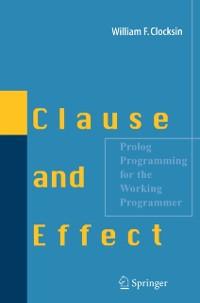
ISBN: 9783642582745
This book is for people who have done some programming, either in Prolog or in a language other than Prolog, and who can find their way around a reference manual. The emphasis of this boo… Mehr…
| Springer.com new in stock. Versandkosten:zzgl. Versandkosten. Details... |

ISBN: 9783642582745
This book is for people who have done some programming, either in Prolog or in a language other than Prolog, and who can find their way around a reference manual. The emphasis of this boo… Mehr…
| ebooks.com new in stock. Versandkosten:zzgl. Versandkosten. Details... |

ISBN: 9783642582745
Clause and Effect - Prolog Programming for the Working Programmer: ab 74.99 € eBooks > Sachthemen & Ratgeber > Computer & Internet Springer Berlin Heidelberg eBook als pdf, Springer Berli… Mehr…
| eBook.de Versandkosten:in stock, , , DE. (EUR 0.00) Details... |

ISBN: 9783642582745
; PDF; Computing > Computer programming / software development, John Benjamins Publishing Company
| hive.co.uk No. 9783642582745. Versandkosten:Instock, Despatched same working day before 3pm, zzgl. Versandkosten. Details... |

2012, ISBN: 9783642582745
Prolog Programming for the Working Programmer, eBooks, eBook Download (PDF), [PU: Springer Berlin Heidelberg], Springer Berlin Heidelberg, 2012
| lehmanns.de Versandkosten:Download sofort lieferbar. (EUR 0.00) Details... |


ISBN: 9783642582745
This book is for people who have done some programming, either in Prolog or in a language other than Prolog, and who can find their way around a reference manual. The emphasis of this boo… Mehr…
ISBN: 9783642582745
This book is for people who have done some programming, either in Prolog or in a language other than Prolog, and who can find their way around a reference manual. The emphasis of this boo… Mehr…

ISBN: 9783642582745
Clause and Effect - Prolog Programming for the Working Programmer: ab 74.99 € eBooks > Sachthemen & Ratgeber > Computer & Internet Springer Berlin Heidelberg eBook als pdf, Springer Berli… Mehr…

ISBN: 9783642582745
; PDF; Computing > Computer programming / software development, John Benjamins Publishing Company
2012, ISBN: 9783642582745
Prolog Programming for the Working Programmer, eBooks, eBook Download (PDF), [PU: Springer Berlin Heidelberg], Springer Berlin Heidelberg, 2012
Bibliographische Daten des bestpassenden Buches
| Autor: | |
| Titel: | |
| ISBN-Nummer: |
Detailangaben zum Buch - Clause and Effect
EAN (ISBN-13): 9783642582745
Erscheinungsjahr: 2012
Herausgeber: Springer Berlin Heidelberg
Buch in der Datenbank seit 2017-05-09T22:44:19+02:00 (Berlin)
Detailseite zuletzt geändert am 2023-12-27T18:40:00+01:00 (Berlin)
ISBN/EAN: 9783642582745
ISBN - alternative Schreibweisen:
978-3-642-58274-5
Alternative Schreibweisen und verwandte Suchbegriffe:
Autor des Buches: john evans, john joseph
Titel des Buches: prolog
Daten vom Verlag:
Autor/in: William F. Clocksin
Titel: Clause and Effect - Prolog Programming for the Working Programmer
Verlag: Springer; Springer Berlin
143 Seiten
Erscheinungsjahr: 2012-12-06
Berlin; Heidelberg; DE
Sprache: Englisch
80,24 € (DE)
82,50 € (AT)
88,50 CHF (CH)
Available
IX, 143 p.
EA; E107; eBook; Nonbooks, PBS / Informatik, EDV/Informatik; Computerprogrammierung und Softwareentwicklung; Verstehen; Mathematica; Programmieren; Programmierung; Prolog; Strukturierte Programmierung; compiler; data structure; data structures; functional programming; language; logig programming; logisches Programmieren; programming; structured programming; B; Programming Techniques; Software Engineering; Programming Languages, Compilers, Interpreters; Artificial Intelligence; Programming Techniques; Software Engineering; Compilers and Interpreters; Artificial Intelligence; Computer Science; Software Engineering; Compiler und Übersetzer; Künstliche Intelligenz; BC
1. Getting Started.- 1.1 Syntax.- 1.2 Programs.- 1.3 Unification.- 1.4 Execution Model.- Worksheet 1: Party Pairs.- Worksheet 2: Drinking Pairs.- Worksheet 3: Affordable Journeys.- Worksheet 4: Acyclic Directed Graph.- 2. Data Structures.- 2.1 Square Bracket Notation.- Worksheet 5: Member.- 2.2 Arithmetic.- Worksheet 6: Length of a List.- Worksheet 7: Inner Product.- Worksheet 8: Maximum of a List.- Worksheet 9: Searching a Cyclic Graph.- 3. Mapping.- Worksheet 10: Full Maps.- Worksheet 11: Multiple Choices.- Worksheet 12: Partial Maps.- Worksheet 13: Removing Duplicates.- Worksheet 14: Partial Maps with a Parameter.- Worksheet 15: Multiple Disjoint Partial Maps.- Worksheet 16: Multiple Disjoint Partial Maps.- Worksheet 17: Full Maps with State.- Worksheet 18: Sequential Maps with State.- Worksheet 19: Scattered Maps with State.- 4. Choice and Commitment.- 4.1 The ‘Cut’.- 4.2 A Disjoint Partial Map with Cut.- Worksheet 20: Multiple Choices with Cut.- Worksheet 22: Ordered Search Trees.- Worksheet 23: Frequency Distribution.- 4.3 Taming Cut.- 4.4 Cut and Negation-as-Failure.- 4.5 Negation-as-Failure Can Be Misleading.- Worksheet 24: Negation-as-Failure.- 5. Difference Structures.- Worksheet 25: Concatenating Lists.- Worksheet 26: Rotations of a List.- Worksheet 27: Linearising.- 5.1 Difference Lists.- Worksheet 28: Linearising Efficiently.- Worksheet 29: Linearising Trees.- Worksheet 30: Difference Structures.- Worksheet 31: Rotation Revisited.- Worksheet 32: Max Tree.- 5.2 Solution to Max Tree.- 6. Case Study: Term Rewriting.- 6.1 Symbolic Differentiation.- 6.2 Matrix Products by Symbolic Algebra.- 6.3 The Simplifier.- 7. Case Study: Manipulation of Combinational Circuits.- 7.1 Representing Circuits.- 7.2 Simulation of Circuits.- 7.3 Sums and Products.- 7.4 Simplifying SOP Expressions.- 7.5 Alternative Representation.- 8. Case Study: Clocked Sequential Circuits.- 8.1 Divide-by-Two Pulse Divider.- 8.2 Sequential Parity Checker.- 8.3 Four-Stage Shift Register.- 8.4 Gray Code Counter.- 8.5 Specification of Cascaded Components.- 9. Case Study: A Compiler forThree Model Computers.- 9.1 The Register Machine.- 9.2 The Single-Accumulator Machine.- 9.3 The Stack Machine.- 9.4 Optimisation: Preprocessing the Syntax Tree.- 9.5 Peephole Optimisation.- 10. Case Study: The Fast Fourier Transform in Prolog.- 10.1 Introduction.- 10.2 Notation for Polynomials.- 10.3 The DFT.- 10.4 Example: 8-point DFT.- 10.5 Naive Implementation of the DFT.- 10.6 From DFT to FFT.- 10.7 Merging Common Subexpressions.- 10.8 The Graph Generator.- 10.9 Example Run: 8-point FFT.- 10.10 Bibliographic Notes.- 11. Case Study: Higher-Order Functional Programming.- 11.1 Introduction.- 11.2 A Notation for Functions.- 11.3 The Evaluator.- 11.4 Using Higher-Order Functions.- 11.5 Discussion.- 11.6 Bibliographic Notes.A workbook for programmers who are new to Prolog and who wish to write useful Prolog programs, by the first author of the runaway bestseller "Programming in Prolog" (with C.S. Mellish).
Weitere, andere Bücher, die diesem Buch sehr ähnlich sein könnten:
Neuestes ähnliches Buch:
9783540629719 Clause and Effect by William F. Clocksin Paperback | Indigo Chapters (William F. Clocksin)
- 9783540629719 Clause and Effect by William F. Clocksin Paperback | Indigo Chapters (William F. Clocksin)
- 9783540652373 Burgers-KPZ Turbulence: Göttingen Lectures (Lecture Notes in Mathematics, 1700, Band 1700) (Woyczynski, Wojbor A.)
- [(Clause and Effect: Prolog Programming for the Working Programmer )] [Author: William F. Clocksin] [Nov-1997] (William F. Clocksin)
< zum Archiv...



